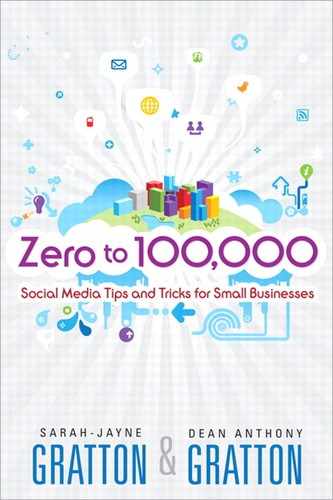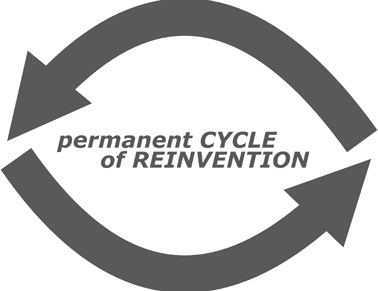9. The Secrets to a Successful Blog
The most memorable blogs, business or otherwise, are written with soul and authenticity—in other words, those that are personal. You and your chosen blog team should all be passionate about your business, and this passion needs to consistently come across in your company blog posts.
Be a Font of Knowledge
Whatever the focus of your post, try to be as useful as humanly possible. By this, we mean that you should endeavor to create a resource for your particular field like no other out there. This doesn’t mean producing posts full of staid facts and figures, but ones that intelligently and concisely inform while keeping your readers entertained. Use your blog as an opportunity to create a resource that’s unique to your arena, to explore new angles, to provide tips and tricks, and to reward your subscribers with an ongoing stream of valuable information.
Remember It’s a Two-way Street
A good blog should be a conversation, starting with your post of course, but continuing on with comments from readers and other bloggers. Get the conversation stirred up by posting questions, polls, and contests for your subscribers. Getting others involved in your blog is the best possible way to ensure it is passed along, mentioned in other social networking platforms, and listed higher in search engine rankings. This involvement also provides material for future posts and perhaps additional blogs based on responses, comments, and so on. These subsequent blogs will become self-generating promotions for your blog and ultimately your business.
Keep Consumer Problems in Mind
As already mentioned in Chapter 8, “Blogging Your Way to Business Success,” it’s important to consider what your customers are looking for in your business arena and to target a philosophy of posts geared toward attracting them. What problems do they have that need to be solved? Your solutions to these problems should form the basis of many of your blog posts, and you should be as useful as possible in answering them. To get a start on this, read other blogs with the same target audience and see what questions the readers are asking. You’ll undoubtedly find a wealth of potential blog post titles from these alone.
Keep Them Wanting More
Ask yourself why you would come back to a blog and what qualities would lead you to subscribe to one. With a wealth of choices available in terms of content, what will make your blog stand out and entice a reader to return? The answer is simple: You need to give your readers a reason to return based on amazing content that you put out from day one and continue to consistently produce on a regular basis. Build a sense of anticipation wherever possible, linking one blog to another and whetting your subscribers’ appetite for more in future posts. Keep them wanting more, and they’ll keep coming back for more.
Make Headlines
You might create the most amazing blog post ever written, but if you accompany it with a poorly thought-out headline or title, your subscribers probably won’t read on. As far as readers are concerned, headlines are the equivalent to movie trailers for your blog. Remember that your posts will be found around the Web and that it’s the headline that draws an audience in initially, so always put some thought into the first words that potential readers and subscribers will see to ensure that you capture their interest and keep it. Pay attention to the popular headlines on other blogs and deconstruct them to analyze what works and why.
A Picture Paints a Thousand Words
Each of the popular blogging platforms makes it easy to add images into your posts. Wherever possible, use pictures that strengthen your message, create and maintain interest, and translate easily across the Web when reposted. When using any external image, check the copyright to be sure that the content owner allows it to be used.
Reinvention Is the Key to Longevity
Another key to long-term social media success lies in keeping your content fresh and relevant. That means not being afraid to diversify it and its style of delivery from time to time. Your blog will undoubtedly become stale if you do the same thing over and over again. When you sense that this is happening, be sure to re-evaluate your content and break out of the cycle. Explore other mediums such as movies and magazines for new ideas and keep your eyes and ears open for blogging inspiration. We look more at this important aspect of social media longevity in Part III of the book, “The 10-Step Method to Building a Fast and Effective Online Presence.”
How to Presell Your Blog Content
With so many blogs out there for the picking, it’s vital that you promote your blog as effectively as possible to as many potential readers and subscribers as possible. You can start doing this even before your blog goes live by proving your authority/knowledge in your particular business arena. Always remember that when promoting your site it’s important to presell your content. Blogs are all about proving you can provide value to a reader in a particular niche. If you achieve this, it’s easy to turn a casual browser into a loyal subscriber.
So let’s get started with these great ways to presell your blog.
Strategize Your Blog Comments
As already mentioned, leaving comments on other popular industry blogs is a great way to acknowledge your expertise in a particular arena. Unfortunately, many businesses do this without a strategy. The trick is to ask questions that require a response and add real value to the post being discussed. Leaving a simple “thank you” remark won’t attract much interest or traffic to your own blog. Make your comments stand out and be noticed by both the blog creator and other visitors to that blog. Always think in terms of initiating a response and bringing something fresh to the post that hasn’t already been covered. When your own blog is underway, consider using a plugin (discussed later in this chapter) to automatically add a link to a complementary post on your blog site. Plugins draw people in and work like a shuttle to instantly transport new readers to your site.
Feature and Contribute Guest Posts
Your blog needs to attract an audience of subscribers who will, over time, translate into customers and advocates of your brand. So, invite prominent guest bloggers from your industry sector and promote their posts prior to publication to bring in a wealth of readers who already follow their posts and who are now an eager audience for your blog.
Similarly, become a guest poster on other well-known industry blogs to establish your credibility and attract readers to your own blog site. When it comes to guest posting, don’t make the mistake of sending rehashed posts from your own blog. Your contributions need to be fresh and provide genuine benefit to the reader that leaves them feeling that they have gained something valuable from reading your contribution. If you achieve this, they will be keen to visit your own blog to learn more from your expertise.
Tweet Your Posts
Use your Twitter account to acquire a list of followers who will be interested in reading your blogs. Again, the trick here is to stand out from the crowd by interacting, retweeting, and asking questions. You want to continually tweet posts that are useful and establish your credibility in your market sector. After you’ve built your reputation, you can start to provide links to your blog posts that you feel your followers might find helpful. Tying in your blog posts to your tweets is fundamental to successful Cross Platform Promotion (CPP), which we cover in greater detail in Chapter 17, “Step 8: Introducing Cross Platform Promotion.”
Use Your Facebook Page
Facebook can be an incredible way to market your blog. Again, interaction is the key here. You want to post questions on your page and describe what’s going on in your new blog in a way that draws interest without coming across as a hard sell or pushiness. Offer links to your best posts that tie in to questions asked and answered on your page. Incorporate responses from those who post on your Facebook page into blog posts wherever possible to draw the reader in. The secret is to make readers feel that you are writing the piece specifically for them.
Create a sense of community within your Facebook page and make it a warm and convivial place to visit. Find out more about aspects of your industry and relay them to your readers in a way that continues to add value to your blog.
Use Personalized Recommendation Engines
Wikipedia (wikipedia.org) describes the likes of StumbleUpon (Stumbleupon.com) and Digg (Digg.com) as “Internet communities that allow users to discover and rate Web pages, photos, and videos. They are personalized recommendation engines which use peer and social-networking principles.”
Correct use of these communities can prove to be an immensely powerful method to bring new readers to your blog (see Figure 9-1 and Figure 9-2).
Figure 9-1. StumbleUpon is an Internet community and personalized recommendation engine that can bring significant traffic to your blog.
(Source: Stumbleupon.com)

Figure 9-2. Digg is another personalized recommendation engine that can bring a significant number of potential subscribers to your blog.
(Source: Digg.com)

You gain respect through these communities by interacting with other users. In this particular instance, it’s important to recommend other people’s posts and create a network of users who will vote on your posts. The posts with the best titles are the ones that get clicked the most so, as mentioned previously in this chapter, you definitely want to write headlines that create curiosity and get you noticed.
Value-Added Blogging Tools
A variety of tools enable bloggers to add value and additional creativity to posts. We provide an overview of the most popular and useful tools available, but first let’s start by clarifying a topic of confusion for many.
The confusion surrounds the difference between a plugin and a widget. Basically, plugins aren’t meant to function on their own, being extensions to existing blogging applications. Their purpose is to enhance the functionality of your blog by offering functions and features that can be customized to suit your blog’s individual purpose. Widgets are like plugins in that they allow you to easily add design elements to your blog by dragging and dropping the ones you want to include. Think of widgets as blog jewelry, visible to your audience and providing creative and fun features to your posts.
Plugins
As previously mentioned, plugins extend the base functionality of your blogging platform and can be used to track statistics, generate random quotes, and more. Each platform has its own plugin directory (see Figure 9-3) where you can view the various options. Experiment with them to find out more about what they can offer in terms of value for your blog.
Figure 9-3. WordPress offers an extensive Plugin Directory with a multitude of options to enrich your blog.
(Source: Wordpress.com)

Be aware that different themes support different plugins and that not all of them will work with your chosen look and feel.
Widgets
Widgets are used to add fun and interesting functional and visual elements to your blog. They appear in your blog’s sidebar and display information that can be pulled from your blog or from other sources such as Facebook and Twitter.
WordPress offers a very simple and easy to use Widgets directory (see Figure 9-4) that lists each widget alphabetically in its own blue bar. An Interactive Widgets box at the bottom allows you to store widgets you have customized without losing their information, which is a very useful time-saving tool.
Figure 9-4. WordPress provides a Widgets section on their dashboard that gives an explanation of each widget they offer.
(Source: Wordpress.com)
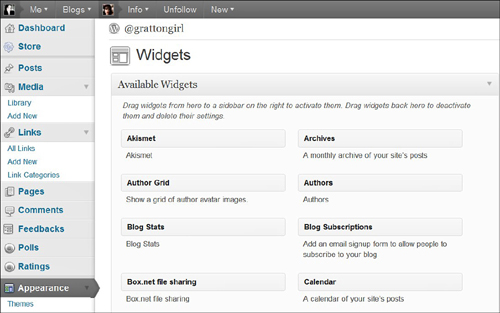
To select a widget, all you need do is to choose the one you prefer and drag it across into the sidebar. As you drag it, a box appears in the sidebar to drop in your chosen widget. Once there, it can be opened for you to customise if necessary, or you can simply save it.
You can move your widgets around into different positions in your sidebar by dragging them to your desired location. The other widgets will move out of the way and create a space for the moving widget.
Really Simple Syndication
Really Simple Syndication (RSS) allows interested readers to follow your blog through their search engine readers or via an email subscription service that sends your latest blog posts directly to their Inboxes. In addition, every time you create a post, a link to it is posted on Facebook, Twitter, or another relevant social networking location you have selected or activated. Your followers or readers can then see your latest blog post as soon as it is created, instead of having to search the Internet to find it. It’s like broadcasting to the virtual world that you have a new post available and automatically sending out a notice to whoever is interested in reading it.
We have favored Google’s RSS process and tools here because many consider it to be the de facto standard, and it is an extremely easy system to adopt. First of all, you need to set up a Google (Google.com) account if you don’t have one already (see Figure 9-5). Then go to FeedBurner (Feedburner.google.com) and sign in with your Google account.
Figure 9-5. Start your RSS process by creating or signing into a Google account.
(Source: Google.com)

After you are logged in, you will see the My Feeds page, as shown in Figure 9-6. Type in your blog’s URL where indicated, and you’ll be taken to a new area where you can select whether to use the blog feed or comments link as the source of the RSS feed.
Figure 9-6. FeedBurner offers one method to incorporate RSS feeds into your blog.
(Source: Feedburner.google.com)
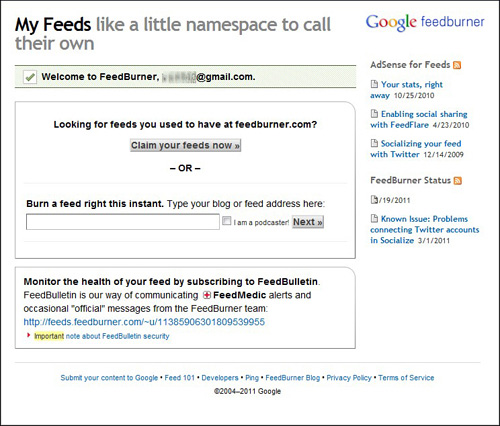
Your blog address will now be verified, and you’ll be given the opportunity to change the title of your feed and its feed address if you would like. We recommend keeping it as is for the purposes of consistency and branding. Make a careful note of your feed address because you’ll need it to subscribe to automatically send your blog feed to the pages of social networking applications (see Figure 9-7).
Figure 9-7. FeedBurner now gives you the option to change the title and address of your feed.
(Source: Feedburner.google.com)
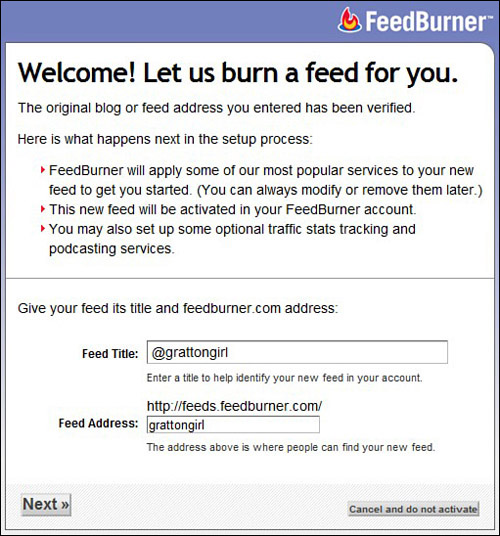
FeedBurner also offers a variety of statistics to help you keep track of who is visiting your blog. We recommend you select both the Clickthroughs and the I Want More options (see Figure 9-8). These options provide additional ways to track reach and popularity of your posts as well as clickthroughs, which are additional members of your blog audience who have found you via their RSS feeds.
Figure 9-8. The FeedBurner stats options provide an opportunity to track the popularity of your posts.
(Source: Feedburner.google.com)

After you set the options for your RSS feed, you can start publicizing it via the platform options available through FeedBurner (see Figure 9-9).
Figure 9-9. Begin publicizing your feed through the platform options available on FeedBurner.
(Source: Feedburner.google.com)
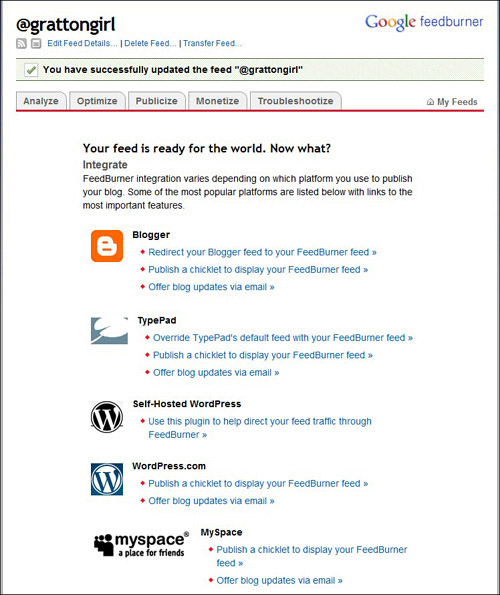
Tags and Tag Clouds
Tags are keywords or phrases that are used by search engines to locate your posts. They are basically “spider food” for the Web and are used to create traffic for your blog. Effective use of tags can dramatically increase the number of readers and, ultimately, subscribers to your blog. Choose those words that best describe the content of your blog posts as your tags. They are primarily listed at both the bottom of your posts and also in the Tag Cloud widget on your sidebar.
Popular tags usually show up as larger than their neighbors in a tag cloud, as illustrated in Figure 9-10.
Figure 9-10. Examples of tag clouds; the most popular tags are shown as the largest in each cloud.
(Source: Jowra.com)

With Google Tag Clouds, you can create tags by either going to the Posts menu in the left sidebar and then selecting the Post Tags page or, after you’ve written a new post, selecting the Post Tags section on the right of the Add New Post page. The latter is more advantageous because you can use the post you just authored to search for the best tags within it.
Embedding a YouTube Video into Your Blog
Log on to your blog and go to your dashboard. Once there, click Post and create the post in which you choose to include your video by first typing out the text and adding a title. Then click the HTML tab to switch to HTML view. Make sure you choose the spot in your text where you want to insert the video.
In a new window, go to YouTube and locate the video you would like to insert into your blog. Under the video, click the Share button, and you’ll see Embed appear as an option (see Figure 9-11).
Figure 9-11. Clicking the Share button allows you to select the Embed option on YouTube.
(Source: Youtube.com)
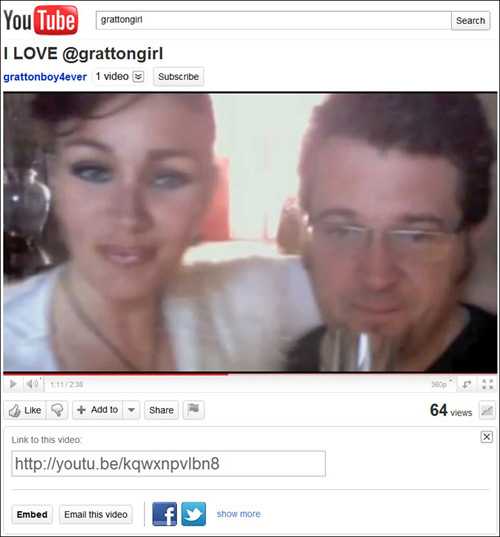
Click Embed, and you’ll see highlighted code in blue (shaded, as shown in Figure 9-12). Now you can copy this and paste it into the area you have designated within your blog. Save your post and click Preview to try it out before finally clicking Publish.
Figure 9-12. Clicking Embed highlights the code you need to insert into your blog.
(Source: Youtube.com)
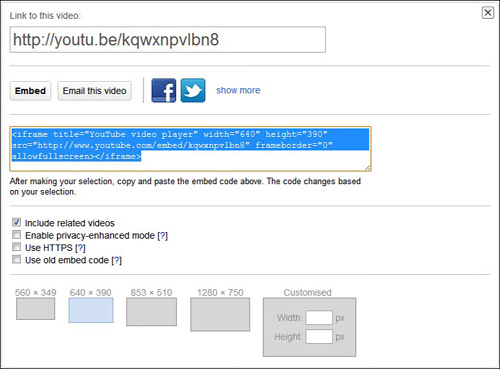
You’ll discover more advanced blogging tips and tricks later on in Parts III and IV of the book, where we also share some exclusive blogging secrets of the social media elite. Now that you know the basic mechanics of the various social media platforms, it’s time to move on to our 10 steps to building a fast and effective online presence.
